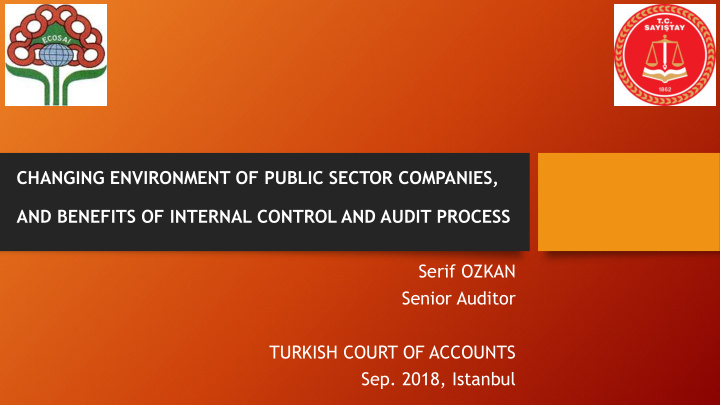



CHANGING ENVIRONMENT OF PUBLIC SECTOR COMPANIES, AND BENEFITS OF INTERNAL CONTROL AND AUDIT PROCESS Serif OZKAN Senior Auditor TURKISH COURT OF ACCOUNTS Sep. 2018, Istanbul
AGENDA 2 I. Constant Change in Companies II. Managing Change III. Benefits of Internal Control and Audit Process IV. Opinions
I. Constant Change in Companies 3 • Change and external environment • The macro environment • The micro environment
II. Managing change 4 • The Internal Dimension • Implementation of change - hard and soft approaches • Managing for Successful Change
Basic Questions of Internal Control 5 Objectives • What are we trying to achieve? • What might thwart our efforts? Risks • How can we manage risk? Controls
III. Essential Components of Internal Control 6 Control Environment Risk Assessment Information and Communication Monitoring Control Activities
Risk Mapping 7 Consider the organization’s risk tolerance and risk appetite related to the risk response IV III 1 II 2 Impact (I) I A B C D E F Likelihood (L) LOW MODERATE HIGH Impact: I – Marginal; II – Material; III – Severe; IV – Catastrophic Likelihood: A – Almost Impossible ; B – Remote; C – Low; D – Reasonably possible; E – Probable; F – Very High
Risk Strategies 8 Mitigation Transfer Avoidance Improve controls to Shift responsibility to Do not proceed! reduce an external party likelihood/impact Creation Seek risk activities Acceptance strategically to Accept the risk! maximize opportunities
Understanding Control Design 9 • Good Controls are: • Focused • Integrated • Accurate • Simple • Accepted • Cost Effective
IV. Opinions 10 Internal Control • Change is inevitable. Change is constant. • Obligations of Internal Control . Change • Duties for Internal Audit Departments and SAI’s Supreme Internal Audit Audit Institutions
RESOURCES 11 • Akyel, R. & Erkan, B. (2012). Achieving Success in Assimilation and Implementation of the ISSAIs (Full text). Journal of Çukurova University Institute of Social Sciences, Akyel, R. (2010). Today's Understanding of Internal Control and Its Reflection on Turkey. TODAİE's Review of Public Administration, • • COSO Executive Summary on updated Internal Control Integrated Framework: http://coso.org/documents/990025P_Executive_Summary_final_may20_e.pdf • Caldeira, Vitor (2012), Enhancing Stakeholder Confidence: Auditing Management Integrity, Accountability and ‘ Tone at the Top', VII. EUROSAI-OLACEFS Conference, Tbilisi. Croft, Liz (2000), Management and Organization in Financial Services: Institute of Financial Services, Financial World PublishingCanterbury, Kent, England. • Görgün, Emin (2011), Türk Kamu Mali Yönetiminde Sayıştay Denetimi [TCA Audit in the Turkish Public Financial Management], Karamanoğlu Mehmetbey Üniversitesi Sosyal Bilimler Enstitüsü, Karaman. • • IFAC (2007), Transnational Auditors Committee , “ Tone at the Top and Audit Quality ”, International Federation of Accountants. • INTOSAI (2007), International Standards for Supreme Audit Institutions ISSAI 40, Mexico Declaration on SAI Indepence. INTOSAI (2010), Capacity Building Committee , “How to Increase The Use and Impact of Audit Reports: A Guide for Supreme Audit Institutions ”. • • INTOSAI Guidance for Good Governance, Internal Control: Providing a Foundation for Accountability in Government. • INTOSAI (2010), International Standards for Supreme Audit Institutions ISSAI 20, Principles of Transparency and Accountability. • INTOSAI (2010), International Standards for Supreme Audit Institutions ISSAI 40, Quality Control for SAIs. INTOSAI Guidance for Good Governance, Internal Control: Providing a Foundation for Accountability in Government. • • ISSAI 40, Quality Control of SAIs, www.issai,org. • ISSAI 100, Basic Principles in Government Auditing, www.issai.org. The Institute of Internal Auditors (2006), The role of Auditing in Public Sector Governance: Professional Guidance. • • The University of North Carolina at Charlotte, Internal Control Training Documents
End of Presentation 12 Thank You! serif.ozkan@sayistay.gov.tr
Recommend
More recommend